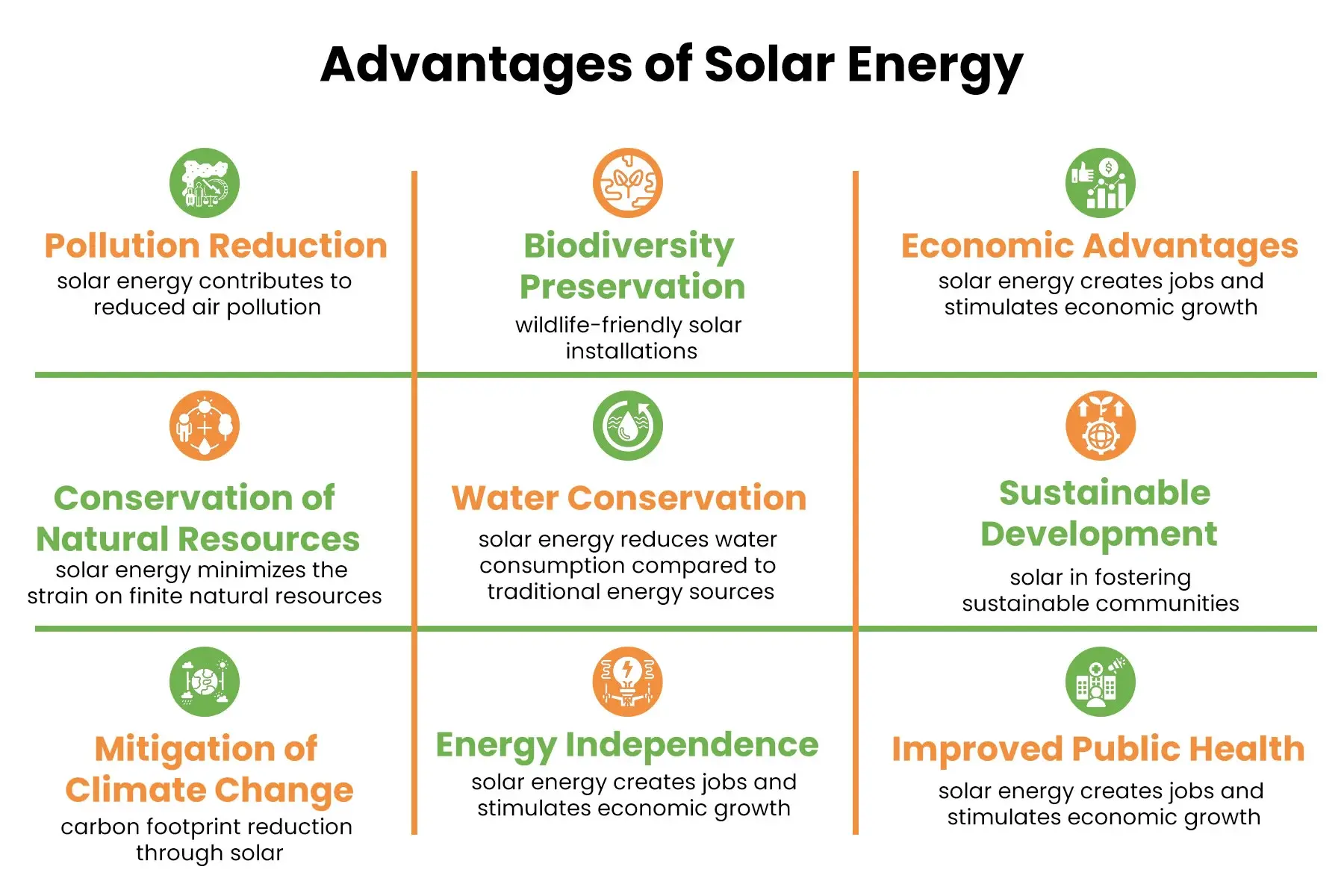In an era where environmental consciousness takes center stage, the inexorable rise of solar energy emerges as a beacon of hope for a sustainable future. Solar energy, derived from the inexhaustible power of the sun, has become a pivotal player in the global shift towards cleaner, greener energy alternatives. As the world grapples with the repercussions of climate change and environmental degradation, understanding the multifaceted benefits of solar panels is not just a choice but a necessity.
In this blog, we will explain the top 9 benefits of solar power, shedding light on its role in mitigating climate change, reducing carbon footprints, and fostering a sustainable energy landscape. It will help you to know about the transformative potential of solar energy and its growing significance in shaping a healthier, more eco-friendly world.
1. Clearing the Air: Solar Energy and Reduced Pollution
Fossil fuels contribute significantly to environmental pollution, generating smog and compromising air quality, posing threats to both the environment and public health while also detracting from aesthetic appeal. In stark contrast, solar power generates electricity with a remarkable reduction in greenhouse gas emissions, particularly carbon dioxide, emitted during the combustion of fossil fuels.
Transitioning to solar energy diminishes the reliance on fossil fuels, curtails the release of greenhouse gases into the atmosphere, and minimizes individual carbon footprints. By adopting solar power, individuals contribute to mitigating the adverse impacts associated with fossil fuel consumption, fostering a cleaner and more sustainable energy future.
2. Preserving Nature’s Gifts: Solar Energy and Resource Conservation
The potential of solar energy is immense; tapping into the sunlight that bathes the Earth for just one hour could provide enough power to sustain the entire world for an entire year. Unlike fossil fuels, which are depleting rapidly, the sunshine used in solar energy production is abundant and free. Shifting away from finite resources and embracing this plentiful source of energy has the potential to lead to lower energy costs, decreased greenhouse gas emissions, and a more robust and stable energy future.
3. Climate Heroes: Solar Energy’s Role in Mitigating Climate Change
Solar energy is a clean, renewable resource that relies on the inexhaustible power of the sun. Unlike traditional energy sources such as fossil fuels, solar power generates electricity without emitting harmful greenhouse gases. By capturing sunlight and converting it into usable energy, solar panels provide a green alternative that is instrumental in mitigating climate change.
Reducing Carbon Footprint: The impact of solar energy on carbon footprint reduction is nothing short of remarkable. According to recent statistics, the adoption of solar power has led to a significant decrease in carbon emissions worldwide. By displacing the need for fossil fuels in electricity generation, solar energy plays a crucial role in diminishing the greenhouse gases responsible for global warming.
4. Harmony with Nature: Solar Energy and Biodiversity Preservation
Solar energy, with its potential to harness the sun’s abundant and renewable resources, offers a beacon of hope for a cleaner future. However, the challenge lies in ensuring that these projects do not inadvertently harm the delicate balance of our ecosystems. By adopting wildlife-friendly practices, we can create solar installations that not only generate power sustainably but also become havens for biodiversity.
Examples of Wildlife-Friendly Solar Installations:
- Floating Solar Arrays: Floating solar installations on water bodies not only maximize the use of available space but also mitigate the environmental impact on land. These installations can benefit aquatic ecosystems by providing shade, reducing water evaporation, and creating habitats for fish and other aquatic species.
- Elevated Solar Structures: Elevating solar panels allows the land beneath to remain untouched, preserving the natural habitat for ground-dwelling wildlife. This design minimizes the ecological footprint of solar projects, promoting the health and diversity of plant and animal species.
- Adaptive Land Use Planning: Integrating solar installations with existing land use patterns is crucial for biodiversity preservation. By identifying areas with minimal impact on wildlife migration routes and habitats, solar projects can coexist seamlessly with natural ecosystems.
5. Solar Wisdom: Conserving Water for Future Generations
One often overlooked aspect of energy production is its significant water demand. Traditional energy sources, such as coal and natural gas, rely heavily on water for cooling and power generation. This exacerbates the strain on already stressed water supplies. In contrast, solar energy systems operate with minimal water requirements, offering an environmentally friendly alternative.
Solar Energy vs. Traditional Sources:
Water Consumption During Power Generation:
- Traditional power plants, particularly those relying on fossil fuels, consume vast amounts of water for cooling purposes.
- Solar photovoltaic (PV) and concentrating solar power (CSP) systems generally require minimal water for their operations, making them more sustainable choices.
Lifecycle Water Footprint:
- Solar panels have a lower water footprint throughout their lifecycle compared to traditional energy sources. The manufacturing and maintenance of solar panels involve considerably less water consumption than the extraction and processing of fossil fuels.
6. Empowering Tomorrow: Solar Energy and Sustainable Development
At the heart of solar energy’s significance is its ability to empower communities. Solar projects contribute to the creation of sustainable living environments by providing a clean, affordable, and reliable source of power. This, in turn, enhances the overall quality of life, supports economic growth, and reduces the environmental impact associated with traditional energy sources.
7. Green Pockets: Solar Energy’s Boost to the Economy
Job Creation:
One of the most significant economic advantages of solar energy lies in its capacity to generate employment opportunities. The solar industry encompasses a wide range of job profiles, from research and development to manufacturing, installation, and maintenance. As demand for solar technologies continues to rise, so does the need for skilled workers, creating a ripple effect that spans across various sectors.
According to recent studies, the solar industry has proven to be a major job creator, outpacing traditional energy sectors. Solar-related employment opportunities not only cater to engineers and scientists but also provide openings for technicians, sales professionals, and administrative staff. This diversity in job offerings contributes to a more inclusive job market, benefiting individuals with various skill sets and educational backgrounds.
Local Economic Impact:
Solar projects have a direct and positive impact on local economies. When a solar installation is planned and executed, it involves collaboration with local businesses, creating a network of suppliers and service providers. This localized approach ensures that a significant portion of the investment stays within the community, boosting regional economic development.
Furthermore, solar energy projects often lead to the revitalization of underutilized or abandoned spaces. Former industrial areas or brownfields can be repurposed for solar installations, bringing new life to these regions. The redevelopment not only generates clean energy but also enhances the aesthetic appeal of the area, potentially attracting additional investments in infrastructure and amenities.
Small and Medium Enterprises (SMEs):
The solar industry provides a fertile ground for small and medium-sized enterprises (SMEs) to flourish. Local businesses can seize opportunities in the supply chain, offering services such as manufacturing components, transportation, and installation. As solar becomes a mainstream energy source, these SMEs play a crucial role in driving economic activity at the grassroots level.
Ready to Go Solar? Explore Novergy’s Top-Notch Solar Power Plant and Rooftop Systems!

8. Breaking Free: Solar Energy and the Path to Energy Independence
One of the key advantages of solar energy is its ability to harness the virtually unlimited power of the sun. Unlike non-renewable resources such as coal, oil, and natural gas, sunlight is an abundant and infinitely available source. By utilizing solar technology, we can tap into this vast resource to generate clean and renewable energy, reducing our reliance on fossil fuels that are not only finite but also contribute significantly to environmental degradation.
Solar power systems, including photovoltaic (PV) panels and solar thermal technologies, have advanced rapidly, making them more efficient and cost-effective. As a result, individuals, businesses, and even entire nations are increasingly turning to solar as a viable alternative to traditional energy sources.
Several countries around the world have made significant strides in achieving energy independence by embracing solar power on a large scale.
- Germany: Often hailed as a pioneer in renewable energy, Germany has successfully integrated solar power into its energy mix. Through robust government incentives and support, Germany has become a global leader in solar energy production, contributing to a substantial reduction in its dependence on non-renewable sources.
- United States: Various states in the U.S. have committed to ambitious renewable energy goals, with solar playing a central role. Initiatives like the Solar Energy Industries Association (SEIA) and state-level incentives have propelled the country towards greater energy independence by harnessing the power of the sun.
- India: With its abundant sunlight, India has set ambitious targets for solar energy capacity. The country is investing heavily in solar projects, aiming to reduce its dependence on fossil fuels and improve energy security.
9. Breathing Easy: Solar Energy and Public Health
One of the most direct and immediate benefits of solar adoption is the decrease in air pollution. Traditional energy sources, particularly those reliant on fossil fuels, contribute significantly to the release of harmful pollutants into the atmosphere. By embracing solar power, we can substantially lower the levels of pollutants such as particulate matter (PM), nitrogen oxides (NOx), and sulfur dioxide (SO2), all of which are known to have detrimental effects on respiratory health.
Parting Thoughts
The environmental advantages of harnessing solar energy are undeniable. The abundance of sunlight presents an unparalleled opportunity to transition towards a more sustainable and eco-friendly future. By relying on solar power, we can significantly reduce our dependence on finite fossil fuels, mitigating the environmental impact associated with their extraction and consumption.
Joining the solar revolution is not merely an option; it is a crucial step towards a greener and healthier planet. Lowering greenhouse gas emissions, curbing climate change, and ensuring a more stable energy future are within our grasp if we collectively embrace solar technologies.
As we strive for a sustainable future, every individual has the power to contribute to positive change. Whether through adopting solar solutions for businesses or industries advocating for solar policies, each action contributes to a more resilient and environmentally friendly world.
Together at Novergy solar, we can make a significant impact and shape a future where our energy needs align harmoniously with the well-being of our planet. Join the solar revolution—it’s a choice for a greener, more sustainable tomorrow.
Contact us at solar@novergy.net for more information.

